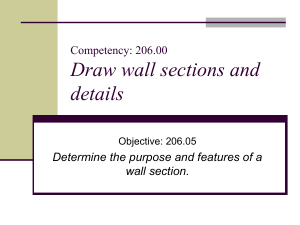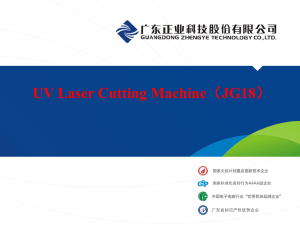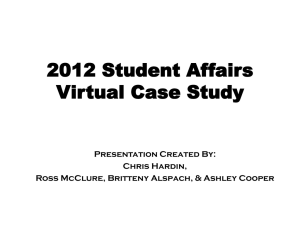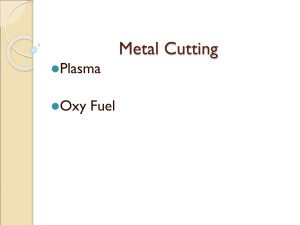Design for Stampings
advertisement
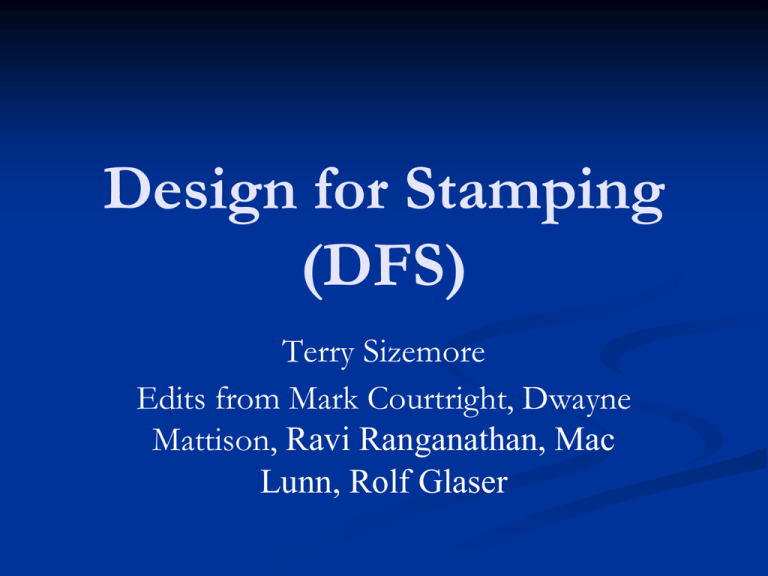
Design for Stamping (DFS) Terry Sizemore Edits from Mark Courtright, Dwayne Mattison, Ravi Ranganathan, Mac Lunn, Rolf Glaser References ■ ■ ■ ■ ■ ■ Eary and Reed: Techniques of Pressworking Sheet Metal, 2nd ed. Prentice Hall Boothroyd, Dewhurst, Knight: Product Design for Manufacture and Assembly, 2nd ed. Marcel Decker Brallia: Design for Manufacturability Handbook, 2nd ed., McGraw Hill Sizemore: EMU MFG 316 Lecture Notes Ulrich and Eppinger SME Journal of Manufacturing Systems Vol23, No3, 2004 (reference 1) Design for Stamping (DFS) ■ Assumptions ■ DFS will be “Design for Stamping” in this lecture ■ DFS applies to sheet materials from 0.026 to 0.1875 inches in thickness (0.884.76mm) ■ Successful use of DFS is measured by: ■ Material utilization percentage ■ Improvement in quality by decreasing Quality Loss (Taguchi’s quality loss function) ■ $$$’s of Die Cost Avoidance ■ Number of processes eliminated ■ Number reduced parts due to adding “Free” features ■ Number of re-orientations eliminated ■ This list of metrics can be applied, not all are equal and you have to consider compromise for your design Product Development ProcessUlrich and Eppenger, 1995 Mission Statement Concept Development Testing/ Refinement Design for Stamping System Design Production Ramp up Detail Design Product Launch Agenda ■ Cutting ■ ■ ■ ■ ■ Properties of Metals (stress strain curve, spring back, etc) Forming ■ ■ ■ ■ ■ ■ Theory of Cutting Sheet Metal Forces for Cutting Die Cutting Operations Bending Embossing and Miscellaneous Forming Drawing Tooling Assembly Design Practices Theory of Cutting ■ Assumptions ■ ■ ■ Theory of Cutting applies to the trimming of forgings, extrusions and castings and the cutting of bar stock Sheet metal is material <0.125” thick Plate is material >0.125” thick Does not apply to brittle materials (i.e. magnesium) Analysis of Cutting ■ ■ ■ Forces applied by the punch and die are shearing forces, which apply a shearing stress to the material until fracture Material deformation occurs in the plane of shear As the tool wears and the clearance between the punch and die grow the material will begin to experience more tensile deformation and less shear deformation prior to fracture Characteristics of a Die Cut Edge ■ Roll Over – Flow of material around the punch and die ■ ■ The larger the clearance the greater the roll over Burnish – The rubbed or “cut” portion of the edge ■ The sharper the punch the wider the burnish Fracture – The angled surface where the material separates from the parent material ■ Burr – The very sharp projection caused by a dull cutting on the punch or die. General Rules: The more dull the tool the greater the burr. The softer the material the greater the burr. *These characteristics are evident on both the hole and slug ■ Penetration Roll Over + Burnish = Penetration Percent Penetrations Material Silicon Steel Aluminum % Penetration 30 60 .10 C Steel Annealed .10 C Steel Cold Rolled .20 C Steel Annealed .20 C Steel Cold Rolled .30 C Steel Annealed .30 C Cold Rolled 50 38 40 28 33 22 E.V. crane, Plastic Working in Presses, John Wiley and Sons, Inc., New York, 1948, p. 36 Die and Punch Clearance Proper Clearance ■ ■ ■ Too Big – Blank ends up with rollover and/or a crown effect. Too Small – Results in large stripping force and secondary shear. Secondary shear is when the fracture propagating from the punch misses the fracture propagating from the die. When proper clearance exists, the fractures meet which yields a preferable break edge. Die and Punch Clearance ■ Force Curves – A common tool for analyzing various clearance conditions is by using strain gages or other transducers to create force vs. displacement curves. Poor clearance conditions result in less than ideal force curves. Other Characteristics ■ ■ Dish Distortion Spacing Distortion – When holes are punched next to each other in sequence distortion in the circularity and position of the first hole will occur. If possible punch closely proximate holes simultaneously. See attached table for recommended design practices. (insert figure and chart from page 20) Forces for Cutting For Cutting: ■ Ferrous stamping materials shear strength is 70-80% ultimate tensile strength ■ Force=Shear Strength*Perimeter of Cut*Thickness ■ When calculating tonnage required it is recommended that ultimate tensile strength be used instead of shear strength to compensate for die wear. Tonnage=(UTS*Perimeter*Thickness)/2000 Forces for Cutting ■ Take caution in what number is used for shear strength or UTS. Consideration must be made for prior operations that may affect the material properties. ■ ■ ■ Work Hardening Annealing or Tempering Other processes that affect the mechanical properties of the material Work and Energy ■ In terms of metal cutting: Work=average force*distance ■ Force: Since the force/displacement curve for cutting sheet metal is nearly rectangular use the maximum force prior to fracture as the average force ■ Distance: The distance used in this calculation is percent penetration (see earlier slide) multiplied by material thickness. ■ This calculation assumes no secondary shear, which will require additional energy during cutting. Example 10 inch diameter aluminum blank made from .032 inch 3003 aluminum (3003 UTS is 11000 psi) Force=(11000)(3.14)(10)(.032) =11053 lbs Tonnage=11053/2000=5.5 tons Work=(5.500)(.600)(.032)=.1056 inch tons* (Need to insert penetration chart page 10) *Most press flywheels are rated in inch ton capacity Cutting Operations ■ ■ ■ ■ ■ ■ ■ ■ Blanking – Material removed is the work-piece Perforating – Material removed is scrap Piercing – Material removed is scrap Lancing – No metal removed, bending and cutting Cut-off/Parting- Separating parts or reducing scrap strip size Notching – Removing material from the outer edges of the strip Shaving – Removing the break edge Trimming – Removing “Flash” from drawn parts Blanking Bending Bending - a metal forming process in which a force is applied to a piece of sheet metal, causing it to bend at an angle and form the desired shape. A bending operation causes deformation along one axis, but a sequence of several different operations can be performed to create a complex part. Perforating * Piercing Lancing Cut-Off/Parting Notching Shaving Shaving The shaving process is a finish operation where a small amount of metal is sheared away from an already blanked part. Its main purpose is to obtain better dimensional accuracy, Trimming Punching away excess material from the perimeter of a part, such as trimming the flange from a drawn cup. Slitting Cutting straight lines in the sheet. No scrap material is produced. Perforating Punching a close arrangement of a large number of holes in a single operation. Dinking A specialized form of piercing used for punching soft metals. A hollow punch, called a dinking die, with beveled, sharpened edges presses the sheet into a block of wood or soft metal. Parting Separating a part from the remaining sheet, by punching away the material between parts. Embossing Embossing is a metal forming process for producing raised or sunken designs or relief in sheet material by means of matched male and female roller dies. Drawing Deep drawing is a metal forming process in which sheet metal is stretched into the desired part shape. A tool pushes downward on the sheet metal, forcing it into a die cavity in the shape of the desired part. Hydro-forming Hydro-forming is a manufacturing process where fluid pressure is applied to a ductile metallic blank to form a desired component shape ■ Cutting ■ ■ ■ ■ ■ ■ ■ ■ ■ Theory of Cutting Sheet Metal Forces for Cutting Die Cutting Operations Properties of Metals (stress strain curve, spring back, etc) Forming ■ ■ Agenda Bending Embossing and Miscellaneous Forming Drawing Tooling Assembly Design Practices Stress/Strain Curves Geology of Stress Strain Curve ■ ■ ■ ■ ■ ■ Elastic Region Yield Point Necking Region Ultimate Point Elongation Spring Back Spring Back Spring-back is the material’s tendency to return to its original shape after forming. This must be anticipated in both the tooling and part design. Darts can be added in bend Radii to help the panel retain its shape. Designer should also anticipate that 90° flanges Will not be possible due to spring back of at least 3°. If 90° is required then additional process will be necessary. Stress/Strain Curves Springback or the elastic strain, is then simply the amount of strain returned to the part as the stress returns to zero Agenda ■ Cutting ■ ■ ■ ■ ■ Properties of Metals (stress strain curve, spring back, etc) Forming ■ ■ ■ ■ ■ Theory of Cutting Sheet Metal Forces for Cutting Die Cutting Operations Bending Embossing and Miscellaneous Forming Drawing Tooling Design Practices Forming Limit Diagram Embossing Drawing Bending * Coining * Embossing * Projection * Hydro-forming Agenda ■ Cutting ■ ■ ■ ■ ■ Properties of Metals (stress strain curve, spring back, etc) Forming ■ ■ ■ ■ ■ ■ Theory of Cutting Sheet Metal Forces for Cutting Die Cutting Operations Bending Embossing and Miscellaneous Forming Drawing Tooling Assembly Design Practices Transfer Dies ■ ■ ■ ■ Most automotive stampings created by transfer press Automation “transfers” part from die to die First picture shows stampings transferred from the side Second picture shows stampings transferred from the front and back Hydro-forming - Bladder press ■ ■ ■ ■ ■ ■ ■ Create only bottom half of the die (cheaper and faster) Sheet metal placed over die Rubber-like material placed over sheet metal High pressure water forms part The dies are less expensive than a transfer press but variable cost will be much higher due to significantly slower cycle times More appropriate for low volume stampings Can form more aggressive shapes than traditional draw forming Progressive Dies ■ ■ ■ Dies fed directly from steel coil No need for blanking operation Scrap gets cut away as part gets formed Surfaces must be flanged instead of drawn home. This requires notches which reduce the strength of the part YouTube Videos on Progresisve Dies ■ ■ http://www.youtube.com/watch?v=10vNgC4LpkQ ■ ■ http://www.youtube.com/watch?v=GKTDgBeEFik&fea ture=fvwrel http://www.youtube.com/watch?v=IgEIt7fnHH4 Rubber Pad Dies Forming Process Selection Chart Transfer Dies Progressive Dies Sheet Hydroforming Investment Required H M L Process Cycle Time M H L Part Variable Cost M L H Class “A” Panels Closure Inner Panel Underbody Cross Members Tire Tubs Reinforcement Brackets Nut Plates Hinges Similar to transfer dies More aggressive shapes possible Suitable Part Design Agenda ■ Cutting ■ ■ ■ ■ ■ Properties of Metals (stress strain curve, spring back, etc) Forming ■ ■ ■ ■ ■ ■ Theory of Cutting Sheet Metal Forces for Cutting Die Cutting Operations Bending Embossing and Miscellaneous Forming Drawing Tooling Assembly Design Practices Design for Stampings ■Assembly Process is considered during the component design ■Assembly sequence and weld placement ■Process Flow ■Assembly equipment layout ■Equipment used and types of part joining ■Process to control variation ■Part variation ■Fixture variation ■Weld gun variation Welding Assembly Design for welding includes manufacturing and assembly considerations during the component development stage Weld points locations and access are considered during the component design Process Flow •High level process flow development provides considerations for : •Design features for needed for assembly •Assembly sequence •Preparation for floor plan layout Assembly Floor plan - Process Flow Assembly equipment layout •Floor plan process flow provides: •Process Sequence •Welding times analysis •Fixture layout •Equipment placement •Robot programming •Part delivery and removal •Piece cost development •Capital expense evaluation Floor plan layouts are a critical step during the design for welding process Assembly Floor plan Assembly equipment layout Floor plan shows sequence of operation of this assembly Assembly Equipment ■ Welding Type by equipment ■ Arc welding ■ Robot with EOAT ■ Pedestal Welder ■ Holding fixture ■ Robot EOAT ■ Weld Nuts ■ MIG Welding ■ Robot with EOAT ■ Laser Welding ■ Robot ■ Ceiling ■ Tape ■ Dispensable Sealer ■ Fixture ■ Holding ■ Part Pass ■ Pedestal welder holding fixture ■ Joining ■ Clinching ■ Riveting Fixture Design Considerations Design for process Variation Figure 2 1. Parts are loaded in the assembly station (Figure 2a) 2. Tooling is closed, deforming the parts to a nominal position (Figure 2b) 3. Parts are assembled / joined together (Figure 2c) 4. Tooling and extra locators are released and the assembly springs back (Figure 2d) Reference 1 The variation within the process needs to be controlled at each station Sources of Variation ■ Part Variation: In the absence of tooling variation, fixture position has no major impact on assembly variation in the presence of part variation. The final assembly variation is only a function of part deviation. The spring-back effect is totally compensated by the relocation effect when fixtures are moved to different positions. Reference 1 Sources of Variation ■ Fixture Variation: In the presence of fixture variation, assembly variation depends on fixture positions. A general rule for variation reduction is to avoid locating non-nominal fixtures close to welding locations and other fixtures. An optimal fixture position can be found. Reference 1 Sources of Variation ■Welding Gun Variation: In the presence of welding gun variation, assembly variation depends on the fixture positions. The guideline for fixture design is to move fixtures as far as possible from the locations of faulty welding gun. This minimizes any restraint to part deformation. In general, the optimal solution locates the fixtures such that they do not provide any support to the parts during the assembly process. However, this general solution is not feasible. Parts must be held or supported at a specific position before assembly. Reference 1 Agenda ■ Cutting ■ ■ ■ ■ ■ Properties of Metals (stress strain curve, spring back, etc) Forming ■ ■ ■ ■ ■ ■ Theory of Cutting Sheet Metal Forces for Cutting Die Cutting Operations Bending Embossing and Miscellaneous Forming Drawing Tooling Assembly Design Practices Stamping Applications ■ ■ ■ Can accommodate many functional features and attachment features Natural uniform wall thickness Can incorporate ■ ■ ■ ■ ■ Springs Snap fit Tabs Spot welding Material Thickness from .001 in to .790 in Production ■ ■ 35 to 500 parts per minute 250000 per year minimum to justify using progressive die ■ ■ ■ Progressive Die should eliminate at least two secondary operations before consideration Short run press tooling – Short run is when the cost of the tool exceeds the cost of the parts Punch presses should be used for low volume parts when possible Materials ■ Any material that can be produced in sheet can be press-worked ■ ■ Deep drawn parts require “Draw Quality” steels Non-ferrous metals may require modified processing or additional processing steps Design Recommendations ■ Shaping and nesting on strip ■ Stamp multiple parts on same strip to increase strip utilization ■ Design part/strip so part can be “cut-off”, not “blanked” ■ Holes ■ Diameter not less than T, spacing should be 2T to 3T ■ 1.5 to 2T between a hole and edge ■ 1.5T + bending radius spacing between surface and hole ■ Use pilot holes Design Recommendations ■ Avoid sharp corners ■ ■ ■ ■ ■ ■ Improves tool wear Increases bur size Lowers stress Minimum radius of .5T or .03125 Be aware of grain direction and how it may change from blank to blank Long sections should greater than 1.5T wide to avoid distortion and a weak problematic tool design Design Recommendations ■ ■ ■ Use stiffening ribs or darts when more strength is needed Use extruded holes when threaded fasteners must be used (1.5 T is the max thread contact you can achieve; progressive dies can do better) Set-outs – used for location, rivets, etc. ■ ■ Height to be .5T Be aware of the burr direction and how the mating part is installed in the hole Dimensional Considerations ■ ■ Spring-back, die wear, material variation (temper, thickness, content) are sources of variation Short run prototype stampings should represent the dimensional population of the production tooled parts to prevent system failures when part goes into production Material Utilization There are two types of material utilization (MUD) Engineering MUD and Process MUD Engineering MUD is the part weight divided by the weight of the minimum amount of material required to make ONLY the outline of the part. This number will run between 80-90% for the average body structure stamping Process MUD is the part weight divided by the weight of the blank that is used to make the part. This is what defines the cost for the part, as you have to purchase all of the material required to make the part. This number is much lower than the engineering MUD number and typically runs between 55-65% for the average body structure stamping


